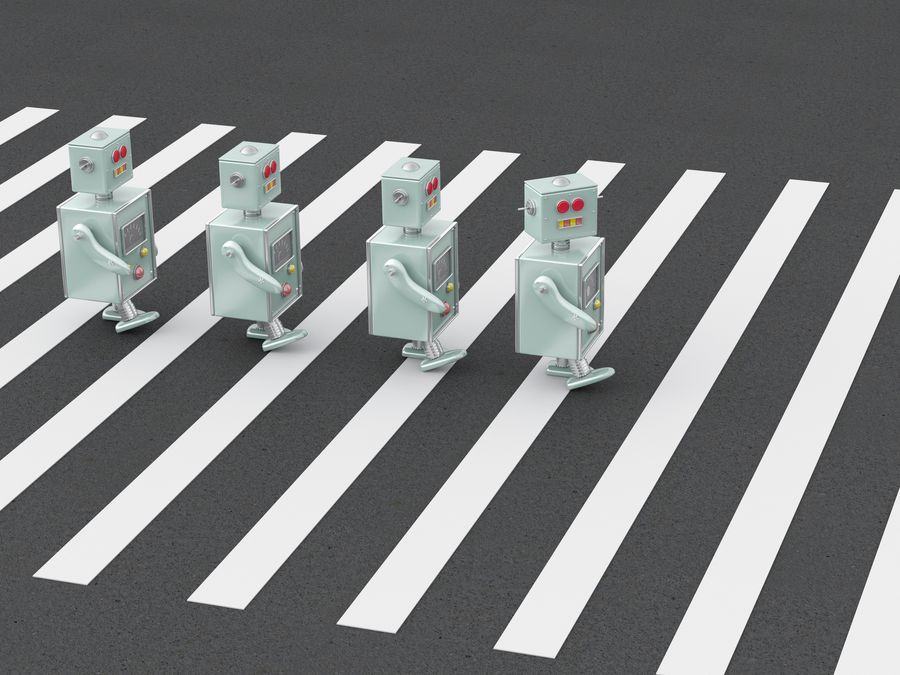Who Wrote That Hit Song? It Depends on How Human They Are.
Copyright and AI will make a twisted pair.
We’re a long way from seeing C3-PO improvise his way through a poetry slam, but it’s not too soon to wonder how we’re supposed to treat the creative work of non-human intelligence. Because while today, machine-learning models remain extensions of human brains, they may not stay there forever. And in the meantime, money stands to be gained or lost depending on how intellectual-property laws govern the output—and input—of AI.
“This is largely a theoretical debate at this point,” said Meredith Rose, policy counsel with the Washington-based advocacy group Public Knowledge.
Her advice: Look past what she called “pop-culture driven ideas of an AI being sentient and inherently creative.” Instead, focus on the current reality of AI as more of a post-processing tool that requires extensive care and feeding by creative humans.
“When I write up neural net experiments, I'm choosing which neural net to train on what data, how it should be sampled, and then curating the results into something that's fun to read,” emailed Janelle Shane, a researcher and author of “You Look Like a Thing and I Love You,” a book breaking down advances in AI.
Shane regularly treats readers of her AI Weirdness blog to such treats as a set of neural-net-composed Christmas carols that led off with these grisly verses:
“The All-gracious King of all the earth,
Had a baby at Christmas time,
On Christmas Day,
A true and holy Deity,
Went down to earth,
With human flesh for sacrifice.”
“In no cases does it make sense to say the copyright should belong to the AI,” Shane said. “The AI is the tool, and human creativity determines how it's used.”
The developers of an AI-powered soundtrack composition service have taken that approach to drive additional revenue: If you use the free or standard plans at Aiva Technologies, that Luxembourg-based firm retains copyright to the output of its tools, while paying for its Pro plan lets you keep those rights.
"They know what makes your heart beat faster,” summed up Gary Arlen, a longtime tech-industry analyst of advances in using AI to craft such movie ingredients as scores and even movie trailers.
Rose’s suggestion for this level of AI development was to apply a common clause in freelance contracts to the product of AI systems. “Expand the work for hire doctrine,” she said. “Let’s treat it like it’s an employee.”
What if, however, an AI could create entertaining works without humans first carefully feeding it a corpus of samples? Then, Rose suggested, take a look at the stated purpose of copyright in the constitution—to “promote the progress” of art. "The machine doesn’t need to get paid, the machine doesn’t need to eat,” she said. "Would this mechanism work to create more work?"
History lends a recent parallel: the monkey-selfie case, in which People for the Ethical Treatment of Animals claimed that a Celebes crested macaque named Naruto owned the copyright to a selfie he’d taken after photographer David Slater left cameras nearby. Slater, meanwhile, contended that he owned the copyright, citing the days he’d spent gaining the trust of the monkeys and the care spent positioning the camera so that the simians would be tempted to try a selfie. Rose rejected that, saying, “things that occur in nature are not copyrightable.” But how fine do you draw the line between the output of one non-human intelligence and another?
In the nearer term, the more likely parallel for AI’s conversation with copyright is the Google Books case #
That’s the long-running suit the Authors Guild filed against Google to stop it from scanning and indexing millions of books, many out of print, and making them searchable. That legal battle ended with Google’s claims being upheld even as a proposed settlement with the Guild collapsed, leaving the copyrighted part of Google’s book archive offline. The 2020 version of that dispute involves a different sort of mass ingestion of copyrighted work: feeding existing creative works into a machine-learning model so it can learn how to make new works along those lines.
“Needless to say, the unauthorized (unlicensed) ingestion of copyrighted works to generate new competitive creative works will ultimately cause market harm to the value of human-created copyrighted works that the AI machines essentially mimic in style and essence,” said Mary Rasenberger, executive director of the Authors Guild, in comments submitted to the U.S. Patent and Trademark Office.
“If we want to preserve a sustainable economy for human authorship in the U.S., we need to create a way for human authors whose works are ingested by AI algorithms and processes to receive remuneration for such use,” Rasenberger said. “As noted above, this will eventually require a sophisticated, automated licensing system.”
The humans directing AIs can work around copyright complaints by training these algorithms on exclusively public-domain works.
“Many of the AI-generated art projects we've seen so far—like The Next Rembrandt—rely on public domain works, possibly to sidestep copyright issues with training data,” noted Amanda Levendowski, an associate professor at Georgetown University’s law school and founding director of its Intellectual Property and Information Policy.
As Rose noted, restricting an AI to a diet of only public-domain works will reflect a much less diverse authorship. As in: “That is white western males who wrote before 1923.” Plus, you need to feed so many works into an AI to train it properly (as in: create something more artful than the AI Christmas carols Shane ushered into the world), so the contribution of any one artist will be trivial.
"Even Prince, who was wildly prolific, is not going to have nearly enough material to train an AI,” Rose said. "There’s such a huge sea, it’s like trying to pick a single drop of seafoam out of the ocean.”
But rightsholders with deep pockets will still want to explore this. Said Arlen: “That’s where the copyright lawyers will get interested.”

